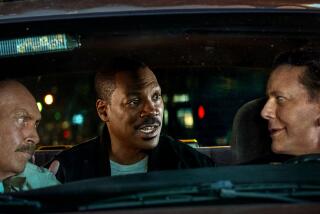FILM COMMENT : Here’s the Deal: ‘The Player’ Takes Hollywood Genre One Step Beyond
If you had to construct the ultimate Hollywood movie, would it include a scene in which a couple of screenwriters pitch a project that’s a cross between “Pretty Woman” and “Out of Africa”? Would your ear be tickled by a lexicon of insider lingo, or a whisper of roman a clef ? Would famous movie celebrities pop up playing themselves as famous celebrities? Would it be about killings--particularly box-office killings?
All this is in Robert Altman’s “The Player.” In fact, a complete catalogue of Hollywood-movie paraphernalia is on view, complete with movie-colony in-jokes for the “knowing.” (Those “Pretty Woman”/”Out of Africa” pitchsters are played by Patricia Resnick and Joan Tewksbury, both of whom have written movies for Altman.)
But Altman has never been content merely to work within a genre when he could radicalize it instead. “MASH” was a war movie for counterculture hipsters; “McCabe and Mrs. Miller” was a Western with a core of poetic longing; “The Long Goodbye” was an updated Raymond Chandler private-eye thriller with a forlorn, galumphing Philip Marlowe at its center.
Is it any surprise, then, that “The Player” up-ends the Hollywood movie genre in the process of fulfilling it? It’s the ultimate Hollywood movie because it seems to be about not only Hollywood but itself. It’s about how insanely difficult it has become for movie artists to get into the position to make a movie as good as “The Player.”
Altman’s outsider-insider status, buffed and beveled to a fine point through years of Hollywood exile, is the perfect weapon for the job. “The Player” is an Altman party without the party hats. Its studio execs and screenwriters and movie stars are imperially self-enclosed. They’re hyper-aware of the high stakes they are playing for; the more powerful they are, the more cooled-out they seem.
Altman had the intuitively right inspiration to fashion this modern Hollywood fable as a farce, but a slow-motion farce in which all the participants have a dreamy, underwater velocity. The piranhas swim in the same golden bowl as the tropical fish, and in a certain light, they’re just as alluring. But what makes “The Player” a great Hollywood movie is that Altman, and his screenwriter, Michael Tolkin (adapting his 1988 novel), aren’t just spear-fishermen here. They’re pulled in by Hollywood’s lethal cool, by the mysteriousness of it, and so are we.
The classic Hollywood movies of the past have usually been wised-up hatchet jobs with a deep feeling for past glories, like Billy Wilder’s “Sunset Boulevard,” or brightly decorated valentines like “Singin’ in the Rain.” Even when the acid etched deep, as in Vincente Minnelli’s “The Bad and the Beautiful,” the film itself certified Hollywood’s supremacy: We were nudged to acknowledge that a corrupt studio system was the price one paid for movie magic--that corruption was even a necessary ingredient in the sorcerer’s mix. The film implicitly asks us: “How bad can Hollywood be if a movie like ‘The Bad and the Beautiful’ can come out of it?” It’s the same question raised by “The Player.”
And the answer, of course, is: Very bad. The magic we observe in “The Player,” as befitting the modern corporate-conglomerate movie era, is all in the Hollywood rituals, not in the movies that come out of them. We don’t even get to see any actual movie-making. It’s as if the films didn’t matter. All that counts is the deal, the “pitch.”
The gallows humor in this farce is that all human transaction has been reduced to the pitch. The wheedling, anxious, fervid tone adopted by the screenwriters hawking their wares to producers is the same tone one hears in the movie between friends and lovers and enemies in the hubbub of the Hollywood parties or in the bistros or the hot tubs. Altman’s overlapping sound techniques have never seemed more appropriate. He understands how, in the Hollywood party circuit, you have to keep your radar tuned to the babble of incriminating frequencies across the room. You never know if your career may be filtering through those squashed syllables.
And yet one of the ways we can sense Altman’s disgust with this milieu is that, for the most part, his soundtrack is eerily, uncharacteristically empty. The jovial chorus of voices familiar from most of his other films has been replaced by a cryptlike creepiness in which the players at the very top measure out their words with a wary calm. Being garrulous isn’t merely uncool. It’s unsafe.
The Hollywood honchos in the film have concocted for themselves a hermetic theme park of a life. Even the desert getaway they favor resembles a movie set; the impossibly beautiful couple swimming langourously in the hot springs grotto could be a pair of movie stars. Or they could be movie-star look-alikes. In the shadows, does it really matter?
The theme park is wired by rumor, and as one of the players says in the film, “the rumors are always true.” There’s a vacuum-packed predictability to the place because so little outside the Land of the Deal is allowed to intrude. Names like “Julia Roberts” and “Bruce Willis” are invoked like mantras. The studio executives’ almost mystical belief in formula plots is all of a piece with their formula lives.
That’s why the film’s chief player--Griffin Mill, the studio exec played by Tim Robbins--is so unnerved when murder complicates his own plot line. He’s a whiz at figuring out where a writer’s pitch is leading, but he can’t figure out what will happen to his own life. And yet he’s not so far gone that he doesn’t find his predicament weirdly entertaining. (That’s why he’s the movie’s hero.) In a way, Mill’s murder rap gives him a status, a gravity, that certifies his high-stakes brinkmanship. In Hollywood, serious players are privileged to commit serious crimes, and murder is way up there--even worse than going $20 million over budget on a film.
Mill even takes up with the girlfriend of the murdered man: an ice princess, played by Greta Scacchi, who matches up with his chilly cool. Scacchi’s character superficially resembles one of those neurasthenic waifs, like Maria in Joan Didion’s “Play It as It Lays,” who used to populate Hollywood novels of the ‘70s. But this waif has more steel; she’ll survive. She’s the modern power player’s ideal mate--an alter ego.
The new Hollywood that Altman shows us still carries the vapor trails of the old. The studio’s inner sanctums are deep-toned and Old World, as if the legendary moguls still hovered inside them. Movie posters from classic and Grade-B crime thrillers from the ‘30s and ‘40s cover the walls. This piece of running-gag art direction is one of Altman’s pop jests, but it also serves to point up the difference between the raw, tabloid force of those films and the blandness of our own.
Altman’s attitude toward Golden Age Hollywood is cautiously sentimental. He recognizes that his artist’s iconoclasm would not have thrived in those years either, but he can still respond to the fervor of that period. At least back then the totalitarians in charge loved the movies.
The Golden Age moguls saw the moviegoing audience in their own outsize image. With new-style producers like Mill, the joke is that they have no image, no contours. Mill has the baby-fatted look of a TV-generation potentate; his gaze has a built-in short attention span. His colorlessness is emblematic of Hollywood’s approach to audiences. What need is there for a producer with a strong, fully formed personality when he can’t act on his riskiest intuitions? The movies are not really being made to satisfy people, they’re made to satisfy a checklist of demographic pre-sale requirements. Is it any wonder that the new generation of movie executives all have the same sleek look of powerful, prefab anonymity? (A witness fails to pick Mill out in a police lineup because of that anonymity.) It’s a more Armani-ized version of the current, preferred look in American business culture, and “The Player” makes us aware of how cleanly and antiseptically Hollywood fits into that culture right now. Despite its deep-down wit and its off-center movie-star cameos, “The Player” is unspeakably sad and unsettling because Altman doesn’t hold out a prayer that any art can come out of all this.
The irony, of course, is that Altman has made a movie that’s supremely deft and pleasurable. As if to taunt his detractors, he even “tells a story” this time, and he does a better job of it than the hacks who have been getting work when he couldn’t. (He still can’t get the financing to make his long-held dream project “L.A. Shortcuts.”) Altman might be saying to us: “You see how easy this is?”
But his flourishes have a Pyrrhic quality. And so, although “The Player” has been hailed as Altman’s triumphant re-entry into Hollywood, emotionally and stylistically it feels more like a leave-taking.
As a state of mind, “Hollywood” has always been a magical aerie for people all over the world; its movies have shaped our fantasies to such an extent that they literally influence the way we dream. What we get in “The Player” is a dreamless community where power-mongering has obliterated art, though not big profits. You don’t have to work in the movie business, or even see a lot of movies, to tune into the message. Altman likes to deal in archetypes. His Hollywood, an American archetype if ever there was one, stands in for a much larger spiritual brutalization.
In the usual Hollywood novel, the screenwriter hero is portrayed as a wronged artist mauled by the studio brass; the book is his revenge. Tolkin put a backspin on this formula when he wrote his novel, with its producer antihero. In the movie, Altman and Tolkin extend the spin. There are no holdouts for artistic integrity in their Hollywood, not even among the writers--the corruption is total. They’ve caught devastatingly well how, in order to score in the new Hollywood, screenwriters have glommed onto the producers’ market-research attitudes while the producers, in their most expansive moments, fancy themselves creators--artists. The screenwriters in “The Player” are enraged not because they are not allowed to function as artists but because they are not being asked to sell out. Or perhaps they don’t have the talent to sell out.
The real murder in “The Player” is the murder of the art of film, and Altman indicts the audience right along with the Hollywood sahibs up on the screen. The connection between murder and power in this film seeps into your bones. In Hollywoodspeak, a good movie is a movie that makes money; a bad movie is a movie that didn’t. Altman’s outrage at this equation is fiercely moral. He recognizes the continuum between this kind of thinking and the scene late in the film in which Mill, dazed by the crime he is caught up in, hears the murdered man’s woman say cryptically to him: “If you don’t suffer, maybe it isn’t a crime.”
It’s a crime that is revenged in the perfect Hollywood manner: Everyone--the guilty and the innocent, the murderer and the provocateur , the sharpies and the stupes--comes out ahead. No one is so loathsome that you might not need them for your career. Besides, what’s a little murder between players?
More to Read
Only good movies
Get the Indie Focus newsletter, Mark Olsen's weekly guide to the world of cinema.
You may occasionally receive promotional content from the Los Angeles Times.






